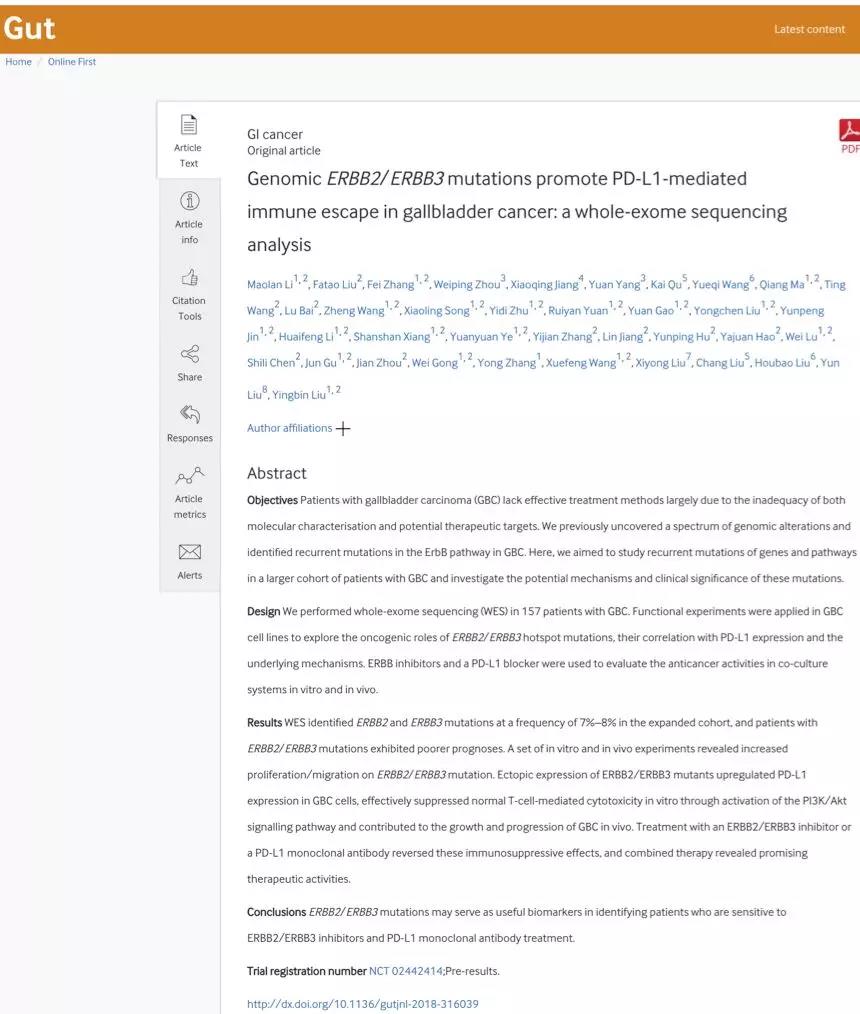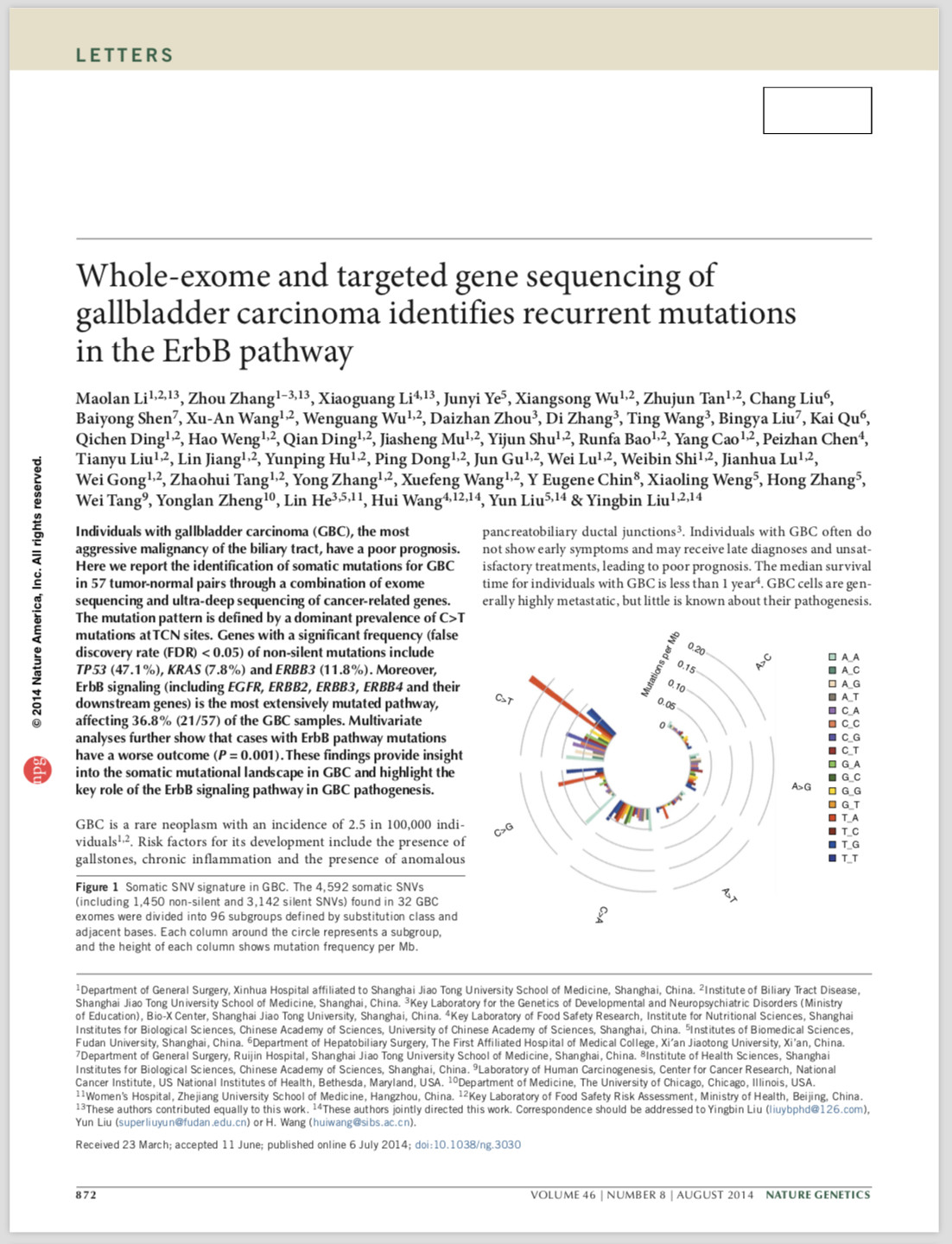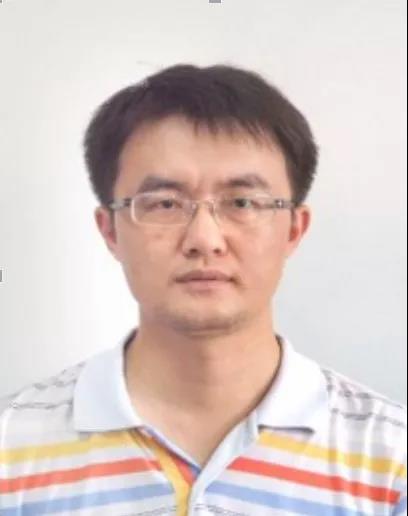上海交通大学医学院附属新华医院普外科暨上海交通大学医学院胆道疾病研究所、上海胆道疾病研究中心、上海市胆道疾病重点实验室(筹)刘颖斌教授团队在原发性胆囊癌研究领域再次取得重大突破。
发现胆囊癌预防和治疗的新途径
6月29日,国际知名学术期刊GUT(影响因子=17.016)以Original article的形式发表了刘颖斌教授团队、复旦大学生物医学研究院浦东医院刘赟副教授、复旦大学中山医院刘厚宝教授团队以及东方肝胆外科医院的周伟平教授、姜小清教授团队、西安交通大学附属第一医院刘昌教授团队协作完成的最新研究成果---Genomic ERBB2/ERBB3 mutations promote PD-L1-mediated immune escape in gallbladder cancer: a whole-exome sequencing analysis (胆囊癌中的ERBB2/ERBB3突变可以促进PD-L1介导的免疫逃逸,一项基于全外显子测序的研究);这项研究是刘颖斌教授团队在胆囊癌研究领域的又一重要突破。

正确认识胆囊癌
胆囊癌具有恶性程度高、对放化疗不敏感等生物学特征,目前治疗主要依靠手术,总体预后极差。近年来我国胆囊癌发病率和死亡率均呈现明显上升趋势,调查显示,80%以上的胆囊癌患者生存不足一年,五年生存率仅为5%。
明确胆囊癌的分子分型、寻找早期高敏靶标,对有效预防和治疗胆囊癌极为重要
刘颖斌教授长期专注于胆囊癌基础及临床研究,运用全基因组外显子和靶向测序技术国际上首次系统阐述胆囊癌基因突变谱,发现驱动胆囊癌发生发展的关键基因和信号通路,揭示了ErbB信号通路的突变与胆囊癌病人预后正相关。
2014年7月6日,国际学术期刊《自然—遗传学》(Nature Genetics)杂志在线发表了这一研究成果: Whole-exome and targeted gene sequencing of gallbladder carcinoma identifies recurrent mutations in the ErbB pathway。

ERBB2/ERBB3已被证实为较为理想的抗癌药物靶标
在此基础之上,刘颖斌教授扩大样本量继续深入挖掘胆囊癌致病机制,除了再次证明前次结果的可信度,更重要的是发现ERBB2/ ERBB3 基因突变明显促进胆囊癌细胞的增殖和转移,并与胆囊癌的预后正相关;随后利用芯片、生物信息学分析、药物干预等技术发现ERBB2/ ERBB3 基因突变可以通过pi3k/Akt信号通路上调PD-L1表达,进一步抑制正常T细胞介导的细胞毒性作用,从而促进了胆囊癌免疫逃和肿瘤的进展。由于ERBB2/ERBB3在多种肿瘤中异常激活,因此成为较为理想的抗癌药物靶标,多种ERBB受体的靶向药物已进入临床使用或处于临床试验阶段。
更多思考
肿瘤免疫逃逸机制一直是制约肿瘤免疫治疗效果的重要因素,然而目前基于PD-L1的治疗措施仍存在对肿瘤免疫逃逸相关抗体缺乏可靠生物标志物、响应率低和副作用多等问题。肿瘤治疗中,多种治疗方法或药物的联合应用往往具有协同效应,在降低药物不良反应的同时, 增强抗肿瘤活性。这项研究为胆囊癌靶向治疗联合免疫治疗提供理论依据;基于这一重要发现,有望发现胆囊癌预防和治疗的新途径;也对未来进一步改善胆囊癌治疗现状、开展胆囊癌综合治疗具有很大的引领作用。
该项研究由刘颖斌课题组李茂岚博士、刘法涛博士、张飞博士等共同完成,并得到了国家自然科学基金委、上海市科委、上海市胆道疾病重点实验室等的基金资助。此项成果也充分展示了多中心、多学科团体合作开展科学研究的优越性。
通讯作者

刘颖斌教授
主要完成人

李茂岚博士

刘法涛博士

张飞博士

刘赟副教授

刘厚宝教授

周伟平教授

姜小清 教授
附:论文题目和摘要
Genomic ERBB2/ERBB3 mutations promote PD-L1-mediated immune escape in gallbladder cancer: a whole-exome sequencing analysis
http://dx.doi.org/10.1136/gutjnl-2018-316039
Objectives Patients with gallbladder carcinoma (GBC) lack effective treatment methods largely due to the inadequacy of both molecular characterisation and potential therapeutic targets. We previously uncovered a spectrum of genomic alterations and identified recurrent mutations in the ErbB pathway in GBC. Here, we aimed to study recurrent mutations of genes and pathways in a larger cohort of patients with GBC and investigate the potential mechanisms and clinical significance of these mutations.
Design We performed whole-exome sequencing (WES) in 157 patients with GBC. Functional experiments were applied in GBC cell lines to explore the oncogenic roles of ERBB2/ERBB3 hotspot mutations, their correlation with PD-L1 expression and the underlying mechanisms. ERBB inhibitors and a PD-L1 blocker were used to evaluate the anticancer activities in co-culture systems in vitro and in vivo.
Results WES identified ERBB2 and ERBB3 mutations at a frequency of 7%–8% in the expanded cohort, and patients with ERBB2/ERBB3 mutations exhibited poorer prognoses. A set of in vitro and in vivo experiments revealed increased proliferation/migration on ERBB2/ERBB3 mutation. Ectopic expression of ERBB2/ERBB3 mutants upregulated PD-L1 expression in GBC cells, effectively suppressed normal T-cell-mediated cytotoxicity in vitro through activation of the PI3K/Akt signalling pathway and contributed to the growth and progression of GBC in vivo. Treatment with an ERBB2/ERBB3 inhibitor or a PD-L1 monoclonal antibody reversed these immunosuppressive effects, and combined therapy revealed promising therapeutic activities.
Conclusions ERBB2/ERBB3 mutations may serve as useful biomarkers in identifying patients who are sensitive to ERBB2/ERBB3 inhibitors and PD-L1 monoclonal antibody treatment.